
Knowledge management (KM) is the collection of methods relating to creating, sharing, using and managing the knowledge and information of an organization. It refers to a multidisciplinary approach to achieve organizational objectives by making the best use of knowledge.
Organizational learning is the process of creating, retaining, and transferring knowledge within an organization. An organization improves over time as it gains experience. From this experience, it is able to create knowledge. This knowledge is broad, covering any topic that could better an organization. Examples may include ways to increase production efficiency or to develop beneficial investor relations. Knowledge is created at four different units: individual, group, organizational, and inter organizational.

Knowledge transfer refers to transferring an awareness of facts or practical skills from one entity to another. The particular profile of transfer processes activated for a given situation depends on (a) the type of knowledge to be transferred and how it is represented and (b) the processing demands of the transfer task. From this perspective, knowledge transfer in humans encompasses an expertise from different disciplines: psychology, cognitive anthropology, anthropology of knowledge, communication studies and media ecology.
Tacit knowledge or implicit knowledge—as opposed to formalized, codified or explicit knowledge—is knowledge that is difficult to express or extract; therefore it is more difficult to transfer to others by means of writing it down or verbalizing it. This can include motor skills, personal wisdom, experience, insight, and intuition.
Knowledge workers are workers whose main capital is knowledge. Examples include ICT Professionals, physicians, pharmacists, architects, engineers, scientists, design thinkers, public accountants, lawyers, editors, and academics, whose job is to "think for a living".
Personal knowledge management (PKM) is a process of collecting information that a person uses to gather, classify, store, search, retrieve and share knowledge in their daily activities and the way in which these processes support work activities. It is a response to the idea that knowledge workers need to be responsible for their own growth and learning. It is a bottom-up approach to knowledge management (KM).
Employability refers to the attributes of a person that make that person able to gain and maintain employment.
Organizational intelligence (OI) is the capability of an organization to comprehend and create knowledge relevant to its purpose; in other words, it is the intellectual capacity of the entire organization. With relevant organizational intelligence comes great potential value for companies and organizations to figure out where their strengths and weaknesses lie in responding to change and complexity.
Business simulation or corporate simulation is simulation used for business training, education or analysis. It can be scenario-based or numeric-based.
Tribal knowledge is knowledge that is known within an in-group of people but unknown outside of it. A tribe, in this sense, is a group of people that share such a common knowledge. In the context of corporations, tribal knowledge or know-how has been described most broadly as the collective wisdom of the organization and the sum of all the knowledge and capabilities of all the people; however, in management science, it is usually viewed as a particular subset thereof: a type of institutional memory that lacks adequate documentation, such that its preservation in the organization over time relies solely on processes such as mentoring, apprenticeship, on-the-job training, and, at the heart of all of those, continuity of staffing, which is inherently vulnerable to employee turnover. It is knowledge that is necessary to an organization's function and yet is inadequately documented or otherwise captured.
Corporate amnesia is a phrase used to describe a situation in which businesses, and other types of co-operative organization, lose their memory of how to do things. The condition is held, by some people, to be analogous to individual amnesia.
Oral debriefing is the interview process of obtaining detailed verbal testimony from individuals. Analogous to interviews that are undertaken in journalism and sociology, its outcome in a comprehensive form is also known as ‘oral history’. Its application is additionally evident in disciplines ranging from psychotherapy, witness interrogation in crime investigations and in industry and commerce, both in oral and visual formats.
A community of practice (CoP) is a group of people who "share a concern or a passion for something they do and learn how to do it better as they interact regularly". The concept was first proposed by cognitive anthropologist Jean Lave and educational theorist Etienne Wenger in their 1991 book Situated Learning. Wenger then significantly expanded on the concept in his 1998 book Communities of Practice.

The DIKW pyramid, also known variously as the DIKW hierarchy, wisdom hierarchy, knowledge hierarchy, information hierarchy, information pyramid, and the data pyramid, refers loosely to a class of models for representing purported structural and/or functional relationships between data, information, knowledge, and wisdom. "Typically information is defined in terms of data, knowledge in terms of information, and wisdom in terms of knowledge".The DIKW acronym has worked into the rotation from knowledge management. It demonstrates how the deep understanding of the subject emerges, passing through four qualitative stages: D – data, I – information, K – knowledge and W – wisdom
A network-centric organization is a network governance pattern which empowers knowledge workers to create and leverage information to increase competitive advantage through the collaboration of small and agile self-directed teams. It is emerging in many progressive 21st century enterprises. This implies new ways of working, with consequences for the enterprise’s infrastructure, processes, people and culture.
Knowledge sharing is an activity through which knowledge is exchanged among people, friends, peers, families, communities, or within or between organizations. It bridges the individual and organizational knowledge, improving the absorptive and innovation capacity and thus leading to sustained competitive advantage of companies as well as individuals. Knowledge sharing is part of the knowledge management process.
A knowledge organization is a management idea, describing an organization in which people use systems and processes to generate, transform, manage, use, and transfer knowledge-based products and services to achieve organizational goals.
Arnold Kransdorff is a British author, business historian and publisher who was the first to identify and directly address the phenomenon of corporate amnesia in the early 1980s, soon after the flexible labour market started to make a significant impact on job tenure and related productivity growth. He specialises in the Knowledge Management (KM) discipline of knowledge transfer of Organisational Memory (OM) to successive generations of replacements.
The following outline is provided as an overview of and topical guide to knowledge:
Corporate DNA refers, in business jargon, to organizational culture. It is a metaphor based on the biological term DNA, the molecule that encodes the genetic instructions in living organisms.


